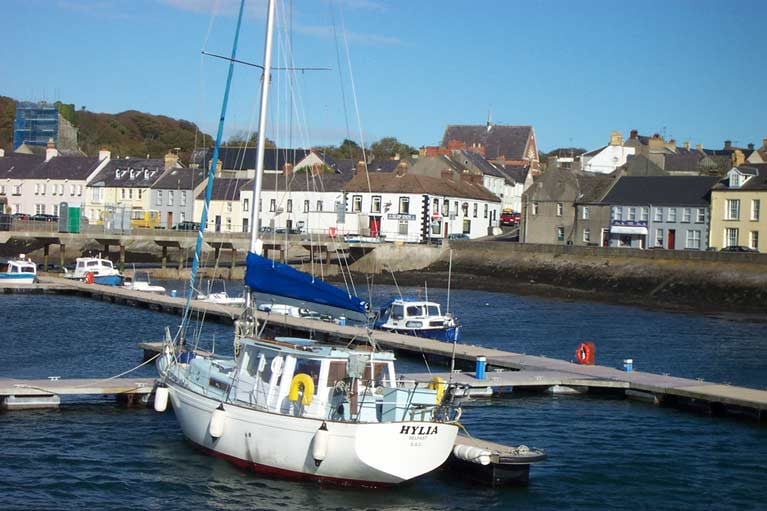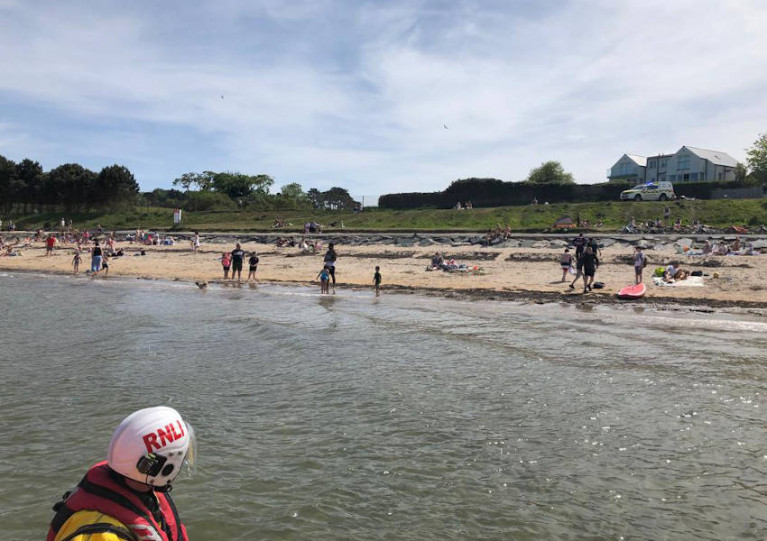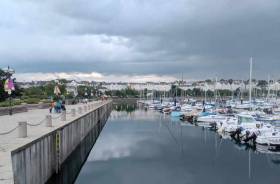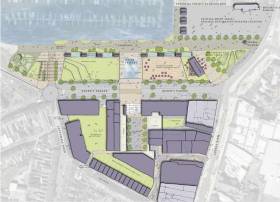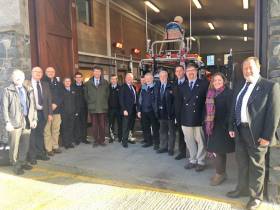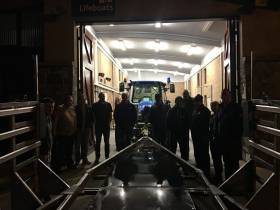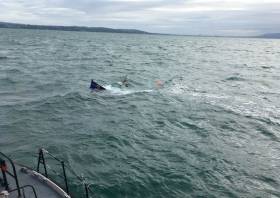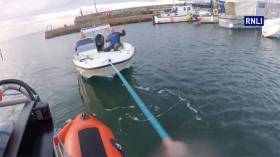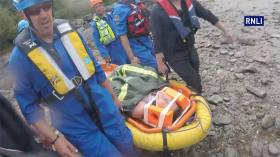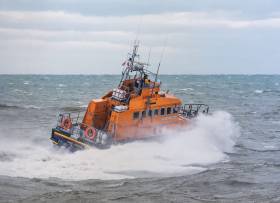Displaying items by tag: Bangor
The situation around the opening of marinas and harbours in Northern Ireland in COVID-19 appears fluid but the latest news is good for those wanting to relax, sail and visit.
Bangor Harbour Master Kevin Baird says that Bangor, Carrickfergus, and Glenarm marinas and harbours are open to visitors but for short stay only – no overnighting.
Also open to all are the Ards and North Down harbours but the Copeland Islands off Donaghadee are completely closed. Marinas and harbours in the Newry and Mourne Council areas are open on the same basis – short stay only.
Belfast Harbour Marina has confirmed that it is open for residents only.
Going north all the Causeway Coast and Glens Marinas and Harbours are now open but only to residents, with the exception of Rathlin Island. It will remain closed for in the short term to all vessels, including visitors. John Morton, Ballycastle Harbour Master, has clarified, “We are not open for any visiting vessels at this time, only resident ones. This will be reviewed over the coming weeks”.
In Strangford Lough, Portaferry Marina has been open for residents and visitors since 25th May but there is no news on Strangford town pontoon or on Foyle Marina in Derry.
The current Foyle Port website posts a Notice to Mariners stating that Foyle Port Marina is closed to visiting vessels and crafts. A further notice will be issued when the marina has re-opened to all.
On the subject of crews, Kevin Baird says, “ Our understanding is that groups of up to six people who do not share a household can meet up outdoors and onboard boats while maintaining social distancing, i.e. two metres”.
Bangor RNLI is appealing to get in touch with the family of a teenage paddle boarder rescued at the weekend after he was blown out into Belfast Lough.
The volunteer lifeboat crew were tasked on Friday afternoon (29 May) after reports of the incident off Grey Point.
Arriving at the scene, they found the 13-year-old boy had been retrieved from the water by a motorboat that has seen him in difficulty, and he was safety returned to the beach at Helen’s Bay.
Bangor RNLI emphasises that the boy had no lifejacket on, and that without the help of others “this could easily have turned into a tragedy”.
Now the lifeboat unit is appealing to contact the boy and his family to invite them to visit the lifeboat station when regulations allow, to find out more about what they do.
“We are also interested to find out from him how he felt when he realised things were going wrong, in the hope that this might prevent others getting into difficulty.”
Bangor Waterfront Project on Belfast Lough to Better Link Town to Sea
Another project in addition to the Bangor Queen’s Parade development on the County Down coast mentioned recently in Afloat, should see the enhancement of a two-mile stretch of the coast from the west of the Bangor Harbour all the way through to the eastern end of Ballyholme Bay writes Betty Armstrong.
Ards and North Down Council has appointed AECOM as consultant for this £60M Bangor Waterfront project to help establish Bangor as a thriving town and prime visitor attraction in Northern Ireland.
The project includes new public realm along the 2.2 mile stretch and new greenways and coastal paths that will better link people to both the town and the sea. Pickie Park, which is already immensely popular with residents and visitors alike, will be enhanced to become a family visitor attraction of national significance and compliment the re-imagining of Ballyholme beach that is also part of the project.
The potential for other innovative features that support the town’s aspiration to revive itself as an attractive, accessible, creative and diverse seaside town will be explored as part of the early work AECOM will undertake.
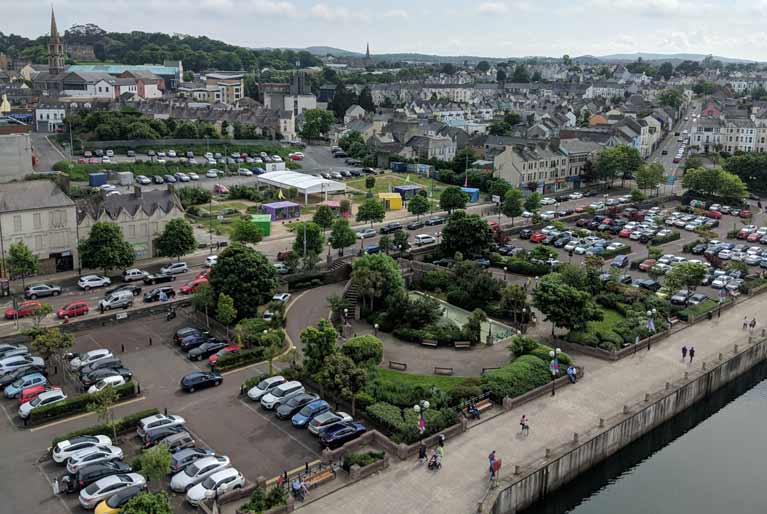 Bangor Seafront
Bangor Seafront
The AECOM team offers extensive visioning, design, environmental and economic expertise. AECOM was the master planner for the London 2012 Olympic and Paralympic Games and has delivered a range of waterfront projects, including Liverpool, Blackpool and in Northern Ireland,the award-winning Newcastle public realm. AECOM has also worked on several projects in Bangor, such as the recent town centre public realm improvements. The AECOM-led team for the Bangor Waterfront project also includes Hemingway Design, Savills and Jettora.
Patrick Clarke, Director – UK & Ireland Masterplanning Lead, AECOM, said: “Building on the ambitious waterfront plan for Bangor, our team brings a breadth of multidisciplinary expertise to further develop this vision, creating a masterplan that will secure long-term tourism and economic benefits for the town and a business case to support future investment in Bangor” Wayne Hemingway, Hemingway Design, added: “We think that Bangor is a town with so many of the ingredients needed to really attract more visitors and be an even more lovely place to live and work, so we’re excited to be a part of this project”.
The Bangor Waterfront Project is one of several exciting tourism-led regeneration schemes due to receive funding from the Belfast Region City Deal. Approximately £40M will be secured via this bespoke package of funding from Westminster, with the remaining investment coming from both the Council and the private sector.
Mayor of Ards and North Down, Alderman Bill Keery, commented: “The appointment of AECOM, and its wider team, is a critical step forward in our plans to regenerate Bangor. They bring a wide range of experience, including the delivery of international coastal regeneration projects, to the table and I have no doubt will challenge and refine our thinking as we progress this very exciting project.”
Bangor’s Queens Parade Gets a New Vision on Belfast Lough
Since Victorian times until about thirty years ago, Queens Parade in Bangor was a thriving seaside thoroughfare with shops, hotels, a cinema, and ice cream vendors all colourfully set in a row, attracting hundreds to that part of the town writes Betty Armstrong.
Sadly, most of the buildings have gone, many are derelict and only artistic type ‘pods’ on waste ground relieve the boredom. In 1989 on the seaward side, the Council built the marina replacing the open bay and the little beach at the bottom of Main Street with a 500-berth haven and associated facilities, a Coastguard station and beside it a boatyard.
But the siting of two huge retail complexes on the outskirts of the town has ruined business in the town centre. Now the Ards and North Down Council, after many proposed and discarded redevelopment plans, has appointed Bangor Marine as the developer to take forward a major £50m regeneration project of Queen’s Parade.
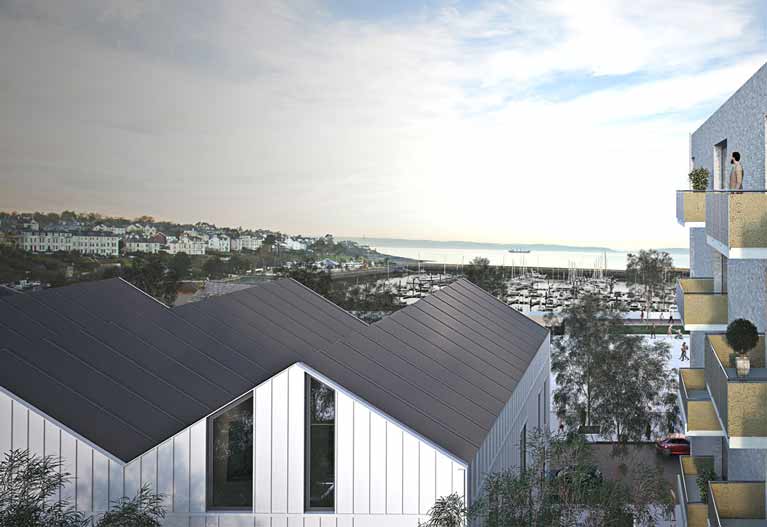 An artist's impression of views from the proposed apartments out over Bangor Marina
An artist's impression of views from the proposed apartments out over Bangor Marina
The proposed scheme is made up of; Marine Gardens Public Realm combining external events space, cafes, sheltered promenade and kiosks, beach, seafront lawns, children’s play area and water feature; a 70/80 bed hotel; a destination/cinema building; residential units; commercial/retail/restaurant space; office Space; a play zone; refurbishment of existing commercial properties; 200 space car park; and marketplace and courtyard squares.
Making the announcement the Department for Communities Permanent Secretary Tracy Meharg said: “This development and the £50m investment in Bangor will generate new jobs, new shops, new offices, new homes and make this area Bangor a place to see and visit. It will help to support a number of areas that we know are important to the vitality of our town centres, especially employment and tourism”.
The then Mayor Councillor Richard Smart said “The regeneration of Queen’s Parade is critical to the future of Bangor and to maximising the economic growth potential of the wider borough of Ards and North Down. With the appointment of Bangor Marine – a consortium made up of a number of leading companies including the Karl Group and Farrans – we are taking a very significant and exciting step forward”.
Aran Blackbourne, Managing Director of the Karl Group commented “The Bangor Marine team are delighted to have signed the Development Agreement to deliver this prestigious and life changing development for the people of Bangor and beyond”.
Bangor RNLI Hosts Visit By Sir Tim Laurence
#Lifeboats - Bangor RNLI was delighted yesterday (Tuesday 29 January) Yesterday afternoon, Bangor RNLI was delighted to welcome a delegation led by Vice Admiral Sir Tim Laurence, Chairman of the RNLI Operations Committee.
Sir Tim and other top RNLI officials met volunteers who run the Bangor lifeboat station as part of the charity’s coastal review.
Together, they spent more than two hours discussing the running of the lifeboat station, the views of management, crew members and fund-raisers, as well as their hopes for the future.
Sir Tim, who is chairman of the RNLI’s operations committee, explained that he and his colleagues visit every lifeboat station in the country in a rolling series of visits to ensure the RNLI remains relevant to each station’s unique needs.
He thanked all the Bangor RNLI volunteers for their commitment to keeping the local waters and shores safe and said how impressed he was to see the high standards set by Bangor are being maintained.
Raise A Toast To RNLI Volunteers This New Year’s Eve
Bangor RNLI has paid tribute to its dedicated lifeboat volunteers after what’s hoped to be its final callout of 2018.
Just after 6.30am this morning (Monday 31 December) the lifeboat was called to assist in the rescue of a vulnerable woman in the water off Carrickfergus.
The inshore lifeboat Jessie Hillyard was stood down after the woman was assisted by land-based rescue services, but according to the Bangor RNLI Facebook page, even this callout illustrated the dedication of its crew.
“Every time the pagers go off, 24 hours a day, seven days a week, 52 weeks a year, our dedicated volunteers drop everything to launch the lifeboat with the aim of saving lives at sea.
“This morning, 16 volunteers turned up at the lifeboat station to help, and while only four were needed to crew the boat, the others stayed around to clean the boat on her return.
“Please raise a glass to them tonight, for everything they do to keep the waters and shore around us safer.
“Please also toast our wonderful fundraising team who work so hard to raise the vital funds we need to provide this service.
“And, thanks to everyone who has contributed their hard-earned money to the RNLI this year — we really do appreciate it.
“Finally, please remember that this is a difficult time of year for many people, and that lives can be saved with a friendly word or a smile.”
Bangor & Donaghadee Lifeboats Launch To Fishing Boat On Rocks
#RNLI - Two RNLI lifeboats were launched on Friday (31 August) at the request of Belfast Coastguard to assist a pleasure fishing boat with four people onboard off Carrickfergus.
Bangor RNLI was first to launch at 3.15pm to reports that a fishing boat had a fouled propeller and was taking on water while drifting ashore onto rocks near Carrickfergus.
Once on scene, the Bangor lifeboat crew established a towline and were able to pull the sinking boat off the rocks, as well as transfer two of its crew to the safety of the inshore lifeboat Jessie Hillyard, where they were given casualty care.
The remaining two fishermen were recovered on the shoreline by coastguard members.
Due to the vessel taking on too much water, the decision was taken to request the assistance of Donaghadee RNLI’s all-weather lifeboat and use its salvage pump to try and save the vessel.
Bangor cut their towline and proceeded to take the two casualties, who were wet and cold, to Carrickfergus and the care of the waiting coastguard crew.
Donaghadee’s volunteers were paged at 4.12pm and proceeded on their lifeboat Saxon at full speed to the last reported location of the sinking vessel.
Upon arrival, the fishing boat was already semi submerged and in the shipping lane, posing a danger to shipping traffic and local boats.
The crew were able to secure a line and tow the boat to shallow waters just north-east of Carrickfergus and prevent it becoming a danger to other boats. Unfortunately, the boat was unable to be recovered.
Speaking after the dual operation, Donaghadee RNLI coxswain Philip McNamara said: “Although unable to make it on time to save the fishing boat, the main concern is the safety of the crew members onboard. Thankfully the speedy response of our colleagues in Bangor ensured the people were brought to safety before the situation deteriorated any further.
“The crew member that requested assistance as soon as they realised they were in trouble did the right thing; the two crew members that made it ashore were very lucky to do so. If in difficulties it can be best to stay with your vessel as long as possible and avoid entering the water if you can.”
In other RNLI news from Northern Ireland, young members of Lough Erne Yacht Club went the extra mile for the lifesaving charity when they held a mini triathlon that raised £310 for Enniskillen Lifeboat Station, based at their club.
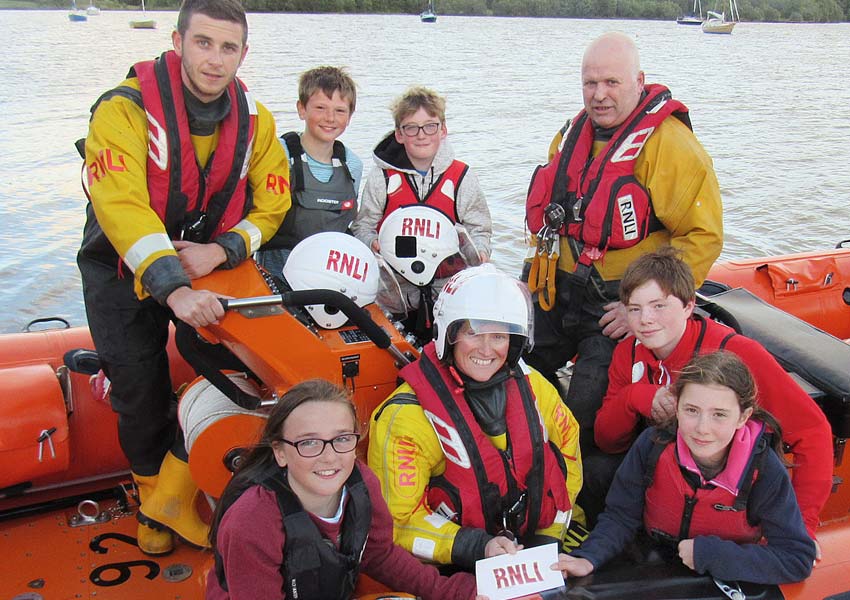
Emma Brines and Emily Torrens along with Peter Brines, Charlie Valentine and Adam Torrens presented the cheque to Lifeboat crew members Olivia Crosgrove, Padraig Lunny and helm Brian McAleer (photo by Bob Torrens). The young sailors thanked club members, family and friends for their support.
#RNLI - Last Wednesday evening (8 August), two men enjoying an evening’s fishing on their speedboat near Groomsport in Co Down hit rocks and lost their propeller.
Bangor RNLI were quickly called to the scene for what was described as “a textbook tow-in” on the part of the volunteer lifeboat crew helmed by John Bell.
Thanks to their skill, it wasn’t long until they were able to hand the rescued vessel over to the Bangor Coastguard Rescue Team and make their way back to Bangor to enjoy what remained of their evening.
More recently, volunteer crew from Bangor launched to a report of a person in the water on the Carrickfergus side of Belfast Lough yesterday, Monday 13 August.
On arrival, however, the crew determined that it was just a cluster of helium-filled balloons, and returned to base.
Bangor Lifeboat Rescues Cyclist After Coastal Path Fall
#RNLI - Bangor RNLI’s volunteer crew headed to the shore in front of Royal Belfast Golf Club early yesterday afternoon (Saturday 7 July) to assist in the rescue of a young woman who had fallen to the rocks below.
Members of the coastguard rescue teams from Bangor and Portaferry and a paramedic from the NI Ambulance Service were already in attendance.
However, due to the inaccessibility of the site for vehicles, the inshore lifeboat was requested to move the casualty, a South African national, to a place where she could be evacuated safely.
Arriving at the scene, due to the shallow waters, members of the crew jumped into the water to walk the boat closer to shore.
Coastguard rescue team members then carried the stretcher with the woman out to the boat, where it was laid across the bow of the boat.
The lifeboat then made its way safely to the slipway at Royal North Yacht Club, where the casualty was transferred to an ambulance and onward to hospital.
Bangor RNLI helmsman James Gillespie thanked his volunteer crew of Russel McKeague, Johnny Gedge and Ian Browne, and said: “This was an excellent example of the RNLI, the coastguard rescue team and the ambulance service working together, and we all wish this young woman a speedy recovery.”
Larne & Bangor Lifeboats Answer Pager Call During Storm Ophelia
#RNLI - Both Larne and Bangor RNLI were requested to launch last night (Monday 16 October) by Belfast Coastguard during Storm Ophelia.
The volunteer lifeboat crew pagers sounded at 9.25pm following reports of a person in the water at Whitehead off the Antrim coast.
Sea conditions at the time were very rough with winds gusting up to 60mph (97kmh).
As the Larne RNLI crew assembled and made preparations to leave the Port of Larne, Belfast Coastguard cancelled the launch following confirmation from the PSNI that two women were ashore safe and well.
Larne Coastguard, Portmuck Coastguard and the PSNI were also tasked to the incident.
Speaking later, Larne RNLI Coxswain Frank Healy said: “During what is extremely challenging weather conditions, I am proud to say 18 volunteers answered the call immediately. This demonstrates our crew dedication to help those in distress at sea.
“Our volunteer lifeboat crews will always launch to rescue those in danger at sea, but to launch into conditions like these could also put their lives at risk.
“I strongly urge people to respect the water and stay away from the coastline during the storm. If you do see someone else in trouble in the water, call 999 and ask for the coastguard. Don’t enter the water yourself as you could also end up in serious danger.”


























